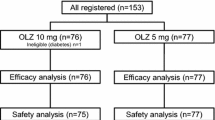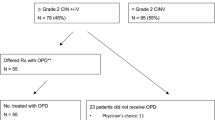Summary
Background To determine the feasibility and efficacy of olanzapine, which is approved by the Pharmaceuticals and Medical Devices Agency as multi acting receptor targeted antipsychotic agent of the thienobenzodiazepine class, for prevention of chemotherapy-induced nausea and vomiting (CINV) in patients undergoing continuous five-day chemotherapy. Patients and methods This study was a prospective dose escalation study at a single center (UMIN ID: UMIN000015386). Patients received a combination of adriamycin and ifosfamide (AI) or a combination of bleomycin, etoposide, and cisplatin (BEP). On days 1–5, all patients received intravenous granisetron (1 mg) and intravenous dexamethasone sodium phosphate (24 mg). Olanzapine was administrated on day-1 to day5 at bedtime. The dose of olanzapine followed a dose-escalation scheme, with monitoring of safety and tolerability at each dose. A 3 + 3 cohort design was used, with three to six patients per cohort. Results Nine patients were enrolled (three for each cohort). No patients experienced dose-limiting toxicity (DLT). The most frequent adverse events were dry mouth and constipation. In each cohort, the maximum severity of nausea was Grade 2, and no patients experienced a vomiting episode. Conclusion A 2.5 mg/day dosage of olanzapine is sufficient to prevent from CINV in Japanese patients receiving continuous five-day chemotherapy. A dose of 10 mg/day, which is recommended by international CINV guidelines, is also tolerated. If CINV is not controlled by an initial dose of 2.5 mg/day of olanzapine, dosage escalation is encouraged. Future studies should compare olanzapine with aprepitant.

Similar content being viewed by others
References
Aapro MS (2007) Palonosetron as an anti-emetic and anti-nausea agent in oncology. Ther Clin Risk Manag 3(6):1009–1020
Kaizer L, Warr D, Hoskins P, Latreille J, Lofters W, Yau J, Palmer M, Zee B, Levy M, Pater J (1994) Effect of schedule and maintenance on the antiemetic efficacy of ondansetron combined with dexamethasone in acute and delayed nausea and emesis in patients receiving moderately emetogenic chemotherapy: a phase III trial by the National Cancer Institute of Canada Clinical Trials Group. J Clin Oncol : official journal of the American Society of Clinical Oncology 12(5):1050–1057. doi:10.1200/jco.1994.12.5.1050
Poli-Bigelli S, Rodrigues-Pereira J, Carides AD, Julie Ma G, Eldridge K, Hipple A, Evans JK, Horgan KJ, Lawson F (2003) Addition of the neurokinin 1 receptor antagonist aprepitant to standard antiemetic therapy improves control of chemotherapy-induced nausea and vomiting. Results from a randomized, double-blind, placebo-controlled trial in Latin America. Cancer 97(12):3090–3098. doi:10.1002/cncr.11433
Basch E, Prestrud AA, Hesketh PJ, Kris MG, Feyer PC, Somerfield MR, Chesney M, Clark-Snow RA, Flaherty AM, Freundlich B, Morrow G, Rao KV, Schwartz RN, Lyman GH, American Society of Clinical O (2011) Antiemetics: American Society of Clinical Oncology clinical practice guideline update. J Clin Oncol : official journal of the American Society of Clinical Oncology 29(31):4189–4198. doi:10.1200/JCO.2010.34.4614
Navari RM, Nagy CK, Gray SE (2013) The use of olanzapine versus metoclopramide for the treatment of breakthrough chemotherapy-induced nausea and vomiting in patients receiving highly emetogenic chemotherapy. Support Care Cancer : official journal of the Multinational Association of Supportive Care in Cancer 21(6):1655–1663. doi:10.1007/s00520-012-1710-6
Navari RM, Einhorn LH, Loehrer PJ Sr, Passik SD, Vinson J, McClean J, Chowhan N, Hanna NH, Johnson CS (2007) A phase II trial of olanzapine, dexamethasone, and palonosetron for the prevention of chemotherapy-induced nausea and vomiting: a Hoosier oncology group study. Support Care Cancer : official journal of the Multinational Association of Supportive Care in Cancer 15(11):1285–1291. doi:10.1007/s00520-007-0248-5
Bymaster FP, Calligaro DO, Falcone JF, Marsh RD, Moore NA, Tye NC, Seeman P, Wong DT (1996) Radioreceptor binding profile of the atypical antipsychotic olanzapine. Neuropsychopharmacology : official publication of the American College of Neuropsychopharmacology 14(2):87–96. doi:10.1016/0893-133x(94)00129-n
Herrstedt J, Roila F, Warr D, Celio L, Navari RM, Hesketh PJ, Chan A, Aapro MS (2016) 2016 updated MASCC/ESMO consensus recommendations: prevention of nausea and vomiting following high emetic risk chemotherapy. Support Care Cancer: official journal of the Multinational Association of Supportive Care in Cancer. doi:10.1007/s00520-016-3313-0
Navari RM, Qin R, Ruddy KJ, Liu H, Powell SF, Bajaj M, Dietrich L, Biggs D, Lafky JM, Loprinzi CL (2016) Olanzapine for the prevention of chemotherapy-induced nausea and vomiting. N Engl J Med 375(2):134–142. doi:10.1056/NEJMoa1515725
Navari RM, Einhorn LH, Passik SD, Loehrer PJ Sr, Johnson C, Mayer ML, McClean J, Vinson J, Pletcher W (2005) A phase II trial of olanzapine for the prevention of chemotherapy-induced nausea and vomiting: a Hoosier oncology group study. Support Care Cancer : official journal of the Multinational Association of Supportive Care in Cancer 13(7):529–534. doi:10.1007/s00520-004-0755-6
Murakami S, Akagi T, Miura K, Matoba M (2011) Japan Society of Clinical Oncology 46(2):1031
Akagi T, Murakami S, Maeda R, Matoba M (2010) Japanese society for palliative medicine
Cleeland CS, Mendoza TR, Wang XS, Chou C, Harle MT, Morrissey M, Engstrom MC (2000) Assessing symptom distress in cancer patients: the M.D. Anderson symptom inventory. Cancer 89(7):1634–1646
Okuyama T, Wang XS, Akechi T, Mendoza TR, Hosaka T, Cleeland CS, Uchitomi Y (2003) Japanese version of the M.D. Anderson symptom inventory: a validation study. J Pain Symptom Manag 26(6):1093–1104. doi:10.1016/j.jpainsymman.2003.05.003
NCI. CTCAE. URL:http://evs.nci.nih.gov/ftp1/CTCAE/About.html. Accessed May, 17, 2010
Kapur S, Zipursky RB, Remington G (1999) Clinical and theoretical implications of 5-HT2 and D2 receptor occupancy of clozapine, risperidone, and olanzapine in schizophrenia. Am J Psychiatry 156(2):286–293. doi:10.1176/ajp.156.2.286
Durand JP, Gourmel B, Mir O, Goldwasser F (2007) Antiemetic neurokinin-1 antagonist aprepitant and ifosfamide-induced encephalopathy. Ann Oncol: official journal of the European Society for Medical Oncology / ESMO 18(4):808–809. doi:10.1093/annonc/mdm104
Sejourne A, Noal S, Boone M, Bihan C, Sassier M, Andrejak M, Chauffert B (2014) Two cases of fatal encephalopathy related to Ifosfamide: an adverse role of aprepitant? Case Rep Oncol 7(3):669–672. doi:10.1159/000368184
Acknowledgements
The authors were responsible for all content and editorial decisions and received no honoraria related to the development of this publication. All authors contributed to the research, writing, and reviewing of all drafts of this manuscript and approved the final draft.
Author information
Authors and Affiliations
Corresponding author
Ethics declarations
Conflict of interest
Author Seiko Bun declares that she has no conflict of interest. Kan Yonemori declares that he has no conflict of interest. Toru Akagi declares that he has no conflict of interest. Emi Noguchi declares that she has no conflict of interest. Tatsunori Shimoi declares that he has no conflict of interest. Akihiko Shimomura declares that he has no conflict of interest. Mayu Yunokawa declares that she has no conflict of interest. Chikako Shimizu declares that she has no conflict of interest. Yasuhiro Fujiwara declares that he has no conflict of interest. Yoshinori Makino declares that he has no conflict of interest. Yoshikazu Hayashi declares that he has no conflict of interest. Kenji Tamura declares research funding from The National Cancer Center Research and Development Fund.
Funding
This work was supported in part by The National Cancer Center Research and Development Fund (26-A-23).
Ethical approval
All procedures performed in studies involving human participants were in accordance with the ethical standards of the institutional and/or national research committee and with the 1964 Helsinki declaration and its later amendments or comparable ethical standards. This article does not contain any studies with animals performed by any of the authors.
Informed consent
Informed consent was obtained from all individual participants included in the study.
Rights and permissions
About this article
Cite this article
Bun, S., Yonemori, K., Akagi, T. et al. Feasibility of olanzapine, multi acting receptor targeted antipsychotic agent, for the prevention of emesis caused by continuous cisplatin- or ifosfamide-based chemotherapy. Invest New Drugs 36, 151–155 (2018). https://doi.org/10.1007/s10637-017-0487-3
Received:
Accepted:
Published:
Issue Date:
DOI: https://doi.org/10.1007/s10637-017-0487-3




